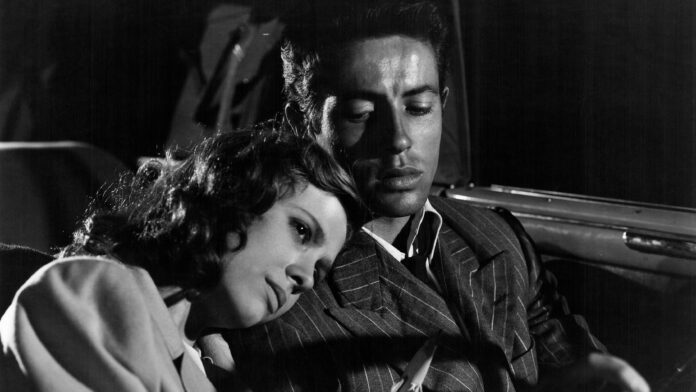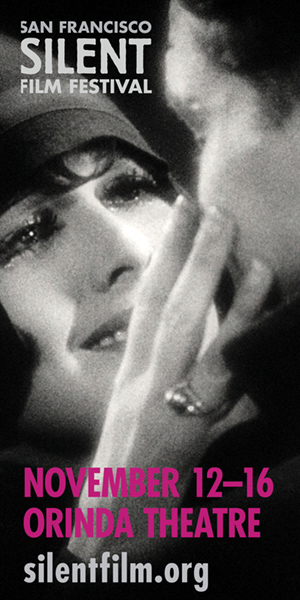The postwar Hollywood crime melodramas that eventually got dubbed “film noir” were, like the gangster sagas which occupied their lurid place in moviegoing popularity during the 1930s, identified almost exclusively with urban life—big cities being where all the sin and violence lived, at least in collective imagination. Of course, small towns have those things too… they’re just better at hushing them up. And a significant minority of noirs during that genre’s original prime era were set well outside the usual metropolis, locating similar perils in seemingly wholesome all-American hamlets, in rural areas, on the open road, or even at sea.
“In Lonely Places: Film Noir Beyond the City,” a seven-week series at Berkeley’s BAMPFA starting this Fri/6, gathers a dozen of those films to cool your summer. It’s named after Imogen Sara Smith’s 2011 book of the same name, and the author herself will be on hand to discuss the first weekend’s features. (SF-based author David Thomson and Noir City founder Eddie Muller will host some later screenings.) They’re a heady quartet of titles from noir’s zenith in the late 1940s and early ’50s, though none are among its most famous classics.
One that certainly should be much better known is 1950’s The Breaking Point, from Hungarian expat director Michael Curtiz (Casablanca, Mildred Pierce, Yankee Doodle Dandy, et al.). Officially a remake, it’s long been overshadowed by the first Bogie-Bacall pairing To Have and Have Not, which came out six years prior. You might be surprised to hear that perennial favorite was rather coolly received by critics at the time, while the more modestly successful Point got highly praised—in both cases ,largely because of their relative faithfulness to the Hemingway fiction they were supposedly drawn from. Its screenplay primarily crafted by another literary lion, William Faulkner, Howard Hawks’ wartime hit bore almost no resemblance to that source material. Curtiz’s version also took liberties, but was advertised as “Screaming Off The Pages Of The Hemingway Story!,” and indeed stuck a lot closer to it—something that mattered in an era where its author was widely considered The Great American Novelist.
This movie, too, has terrifically snappy dialogue and players well-equipped to punch it across. But in the place of Bogart’s sardonic swagger we’ve got angsty John Garfield (in his penultimate vehicle, two years before a fatal heart attack at age 39), and taking the impeturbable Bacall’s place is an atypically tawdry, peroxide-blonde young Patricia Neal. He’s a hot-tempered war veteran turned husband, father, and commercial boatsman in a seaside Southern California community. She’s a leering lady-for-hire whose current gig is as temporary mistress to a big shot who hires our hero’s boat for a pleasure cruise to Mexico. When that high roller loses his bankroll at cards, he ditches both dame and ride, leaving Garfield without even the cash to return home. He’s forced to take on some less-than-strictly-legal business that leads straight down a rabbit’s hole of criminal involvement. Meanwhile his wife (Phyllis Thaxter) frets, not least over the lingering presence of brassy Neal, who makes no secret of her attraction towards this surly-but-honorable Average Joe.
Garfield, a reluctant Hollywood star who never liked the industry—he was among the first actors to start his own production company as an end-run around studio interference—is at his best here, a singular working-class-hero presence incapable of a false note. He’s surrounded by the kind of supporting cast where every face seems familiar, and nails a particular type. The Breaking Point is an excellent thriller that Curtiz keeps from ever seeming contrived or hyperbolic. It also has a memorable ending that’s at once “happy” and tragic, with a tacit eloquent indictment related to Juano Hernandez’s low-key but admirable turn as our protagonist’s trusted Black shipmate.
Breaking Point is unusual for managing to fit noir’s usual moody, shadow-riddled visual aesthetic into a story at least partly set at sea. Two of this weekend’s other films, both released in 1947, transfer the genre’s look and feel into the equally wide-open spaces of the Western. Raoul Walsh’s Pursued is one of the most florid expressions of Hollywood’s then-obsession with Freudian “psychology,” as figures played by Robert Mitchum, Teresa Wright, Dean Jagger, and Judith Anderson wrestle with a motherlode of neuroses amongst the sagebrush. James Wong Howe’s B&W cinematography could not be any more noirishly chiaroscuro, Niven Busch’s more pretentiously “literary,” or Max Steiner’s score any more hysterical. Equally fraught with ill-repressed emotions is Lewis Allen’s Desert Fury, an adult oater in blazing color in which casino queen Mary Astor and rebellious collegiate daughter Lizabeth Scott wrangle with local sheriff Burt Lancaster, plus a couple crims from mom’s shady past. As the latter duo, John Hodiak and Wendell Corey sport an unspoken-but-undeniable frisson of jealous same-sex attachment that’s been debated by film and gay historians ever since.
A fourth film playing opening weekend was considered a throwaway “B” in 1953, but has gained stature since as a personal best from Ida Lupino, the actress who was (alongside Dorothy Arzner) just about the only woman Hollywood allowed into the director’s chair during its “golden age.” The Hitch-Hiker is an economically tense thriller in which two staid men on a camping trip find themselves taken hostage by a homicidal maniac. He forces them to drive deep into alien (Mexican) territory, where life-or-death stakes become even more palpable. Also falling into the category of a nightmare road movie are Edgar G. Ulmer’s infamous 1945 Detour (which shows Wed/25), a nihilistic fever dream shot on the slimmest budgetary means, and Nicholas Ray’s 1948 debut feature They Live By Night (July 2), with Farley Granger and Cathy O’Connell as doomed young lovers on the run.
Other titles memorably portray solidly middle-class, all-American milieus invaded by evil: In Hitchcock’s 1943 Shadow of a Doubt, one of the earliest films that could be dubbed noir, a naive smalltown teenager (Teresa Wright again) discovers her beloved visiting uncle (Joseph Cotton) just might be a serial killer. In Max Ophuls’ 1949 The Reckless Moment, housewife Joan Bennett is cornered into all kinds of unsuitable situations (including those with blackmailer-ally James Mason) to hide her daughter’s involvement with a murder. Most startling is John M. Stahl’s Leave Her to Heaven, the second biggest box-office hit of 1945, just behind sugary, pious The Bells of St. Mary’s—its perverse antithesis, with Gene Tierney ravishing in Technicolor as the picture-perfect New England debutante who turns out to be a perfectly ruthless, lethal sociopath.
Help us save local journalism!
Every tax-deductible donation helps us grow to cover the issues that mean the most to our community. Become a 48 Hills Hero and support the only daily progressive news source in the Bay Area.
The series ends later on in July with three very striking films: Orson Welles’ masterful 1958 Touch of Evil, in its longer 1998 restoration, before Universal imposed drastic changes; Edmund Goulding’s 1947 version of the carny-world-set pulp novel Nightmare Alley; and Phil Karlson’s 1955 The Phenix City Story, a tale of small-town Southern corruption that is one of an underrated director’s greatest achievements. For full schedule and program info on “In Lonely Places: Film Noir Beyond the City,” which runs June 6-July 24, go here.
Another retrospective of note is occurring next week, at the Palo Alto Stanford Theater’s 100th anniversary with five days of programming from the later U.S. silent era. A big star in that period who became a reliable supporting player after the arrival of sound (his career stretched as far as the mid-’60s Batman series), handsome, spirited Reginald Denny made a personal appearance to open that venue on June 9, 1925. A century later, his granddaughter will host an evening of two among his many comedic vehicles, that year’s I’ll Show You the Town and 1927’s That’s My Daddy. On Tue/10, his 1926 Rolling Home is paired with Harold Lloyd’s The Freshman, while on Thu/11, Skinner’s Dress Suit from the same year plays alongside Buster Keaton’s Steamboat Bill, Jr. The pre-talkie flashback concludes Thu/12 with another Lloyd (Speedy), an atypical comedy vehicle for Gloria Swanson (Stage Struck), and finally on Fri/13, King Vidor’s 1928 drama The Crowd, a commercial failure since regarded as among the then already-waning silent art form’s finest hours. For more info, go here.
Half a century after the death knell began ringing for silent cinema, there came the audiovisual riot of Hausu aka House, a first commercial feature for prolific Japanese experimental and commercials director Nobuhiko Obayashi. It’s taken nearly that long again for it to become a cult film in the West, which in turn has fostered interest in his other works. He continued making them right up to his death at 82 in 2020—some of his most ambitious endeavors coming at the end, after he was diagnosed with terminal cancer. The Roxie’s “Early Obayashi: Youth, Ghosts, Islands” series (Mon/2 to June 16) commences with Hausu, which plays again this Sun/8. But the remaining two films in the series are equally eccentric, if very different thematically from his “greatest hit’s” comedy-horror blowout. Both are being shown in new restorations.
Starting this Fri/6, the 1986 His Motorbike, Her Island is a cheerfully bizarre mix of juvenile delinquency, Kawasaki fetishism, rebel-youth romanticism, and this director’s typical willingness to throw anything/everything that comes to mind into the pot. Tokyo motorcycle messager Koh (Riki Takejuchi) is a guitar-playing ramblin’ guy who abandons his “boring” latest girlfriend (“all she knows is cooking and crying”) the second he lays eyes on rural free spirit Miyo (Kiwako Harada), whose lack of inhibitions extends to frequent nudity. Another paean to nonconformity is 1981’s School in the Crosshairs (playing as of Fri/13), whose high school heroine Yuka (Yakushimaru) discovers she has paranormal abilities. But this effort is as much Xanadu as it is Carrie, with Yuka so perky you expect unicorns and butterflies to materialize in her wake. Indeed, the film does have whimsical animation elements—and a live-action chimpanzee, for no obvious reason. These restlessly, recklessly inventive movies, which are also semi-musicals, often seem to deploy diverse stylistic elements and random narrative turns simply to keep their own director amused.
Dangerous Animals
Moving from the fantastical to the fatal, there’s Sean Bryne’s new thriller Dangerous Animals. He made his feature debut in 2009 with The Loved Ones, a startlingly macabre Australian black comedy/horror about the extreme consequences that rain down upon one nice high school boy who’s declined a seemingly nice classmate’s prom invitation. It took him six years to make an interesting-if-less-impressive followup, The Devil’s Candy, and a solid decade more for Animals, which opens in Bay Area theaters this Fri/6.
It begins with the requisite ominous prologue in which two young tourists day-trip with a Gold Coast boatsman (Jai Courtney as Tucker) for hire—just like John Garfield in The Breaking Point, except that he’s not a surly good guy but an excessively bad’un matey who ensures they’ll never return to land. We then meet Zephyr (Hassie Harrison from Yellowstone), a surfing loner who cuts out from her one night stand with nice guy Moses (Josh Heuston) before dawn to hit the waves. Unfortunately, en route she’s shanghai’d by guess-who. He normally takes tourists out to go safely “swimming with the sharks”—but he also abnormally enjoys feeding the sharks, if you know what I mean.
The first movie Byrne hasn’t written himself, this has a pretty strong screenplay by Nick Lepard. Its twists offset a rather nasty concept and occasionally soft-headed dialogue, two things that do not complement each other. It is expertly crafted, tense, and at-times grotesque—not as memorably so as The Loved Ones, but it’ll do. If you’re looking for a shark-centric thriller with which to observe the 50th release anniversary of Jaws, here ya go. There’s even an in-joke further tying the two together: The Spielberg movie notoriously had production difficulties with the mechanical beast its crew dubbed “Bruce the Shark,” and villain Tucker’s own little-mentioned first name is… well, you can fill in that blank.





